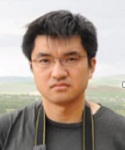| Biography | |
|---|---|
 Dr. Peng Zhan Nanjing University, China |
|
| Title: Engineering Extreme Electromagnetic Field Enhancement in Free Space for Molecule Sensing | |
| Abstract:
Gap plasmon resonance is an important optical phenomenon that can create strong electromagnetic (EM) field in dielectric media and metals with many emerging applications in high precision chemical and biological sensing. In this talk, we would like to introduce a novel family of plasmonic nanostructure created through a unique process using nanoimprint lithography that enables the precise engineering of the gap plasmon modes. The resulting gap plasmon device can achieve chemical detection at the single molecular level while having high areal density of hotspots in free space. The nanostructure features arrays of physically contacted nanofinger pairs with an ultrathin 2 nm tetrahedral amorphous carbon (ta-C) film as the dielectric gap. This record miniaturization of the dielectric thickness compared to the traditional approaches is enabled by the selection of ta-C film as the medium material, which offers a large tunneling barrier height due to its small positive electron affinity and suppresses the probability of electron tunneling across the gap. In addition, due to the high electric permittivity of the ta-C dielectric, the redistribution and abrupt increase of EM field across the ta-C/air boundary lead to extensive spill-out of the coupled EM field from the dielectric gap, giving rise to record field enhancement in free space. The multitude of benefits deriving from the unique nanostructure hence allows extremely high chemical detection sensitivity to be realized at the real single-molecular level as proven by the bi-analyte surface-enhanced Raman scattering (SERS) measurement.
| |
| Biography:
Dr. Zhan received his B. S. and Ph. D degrees from Department of Physics, Nanjing University in 2000 and 2006, respectively. During 2006 to 2009, he was a Postdoctoral Research Fellow at Department of Electric Science and Engineering of Nanjing University, and at Department of Mechanical Engineering of Northwestern University in U.S. Since 2009, he has been a faulty member and is currently an associate professor in School of Physics, Nanjing University. He was a recipient of Nomination awards of the national outstanding Doctoral dissertations by the Ministry of Education in 2008. Now his main research interests and activities include nanophotonics and 2D & 3D plasmonics nanostructures studies with particular interests in plasmon-enhanced light matter interactions at nanoscale and their applications in biochemical sensing, light harvesting, energy conversion and optoelectronic devices.
| |
